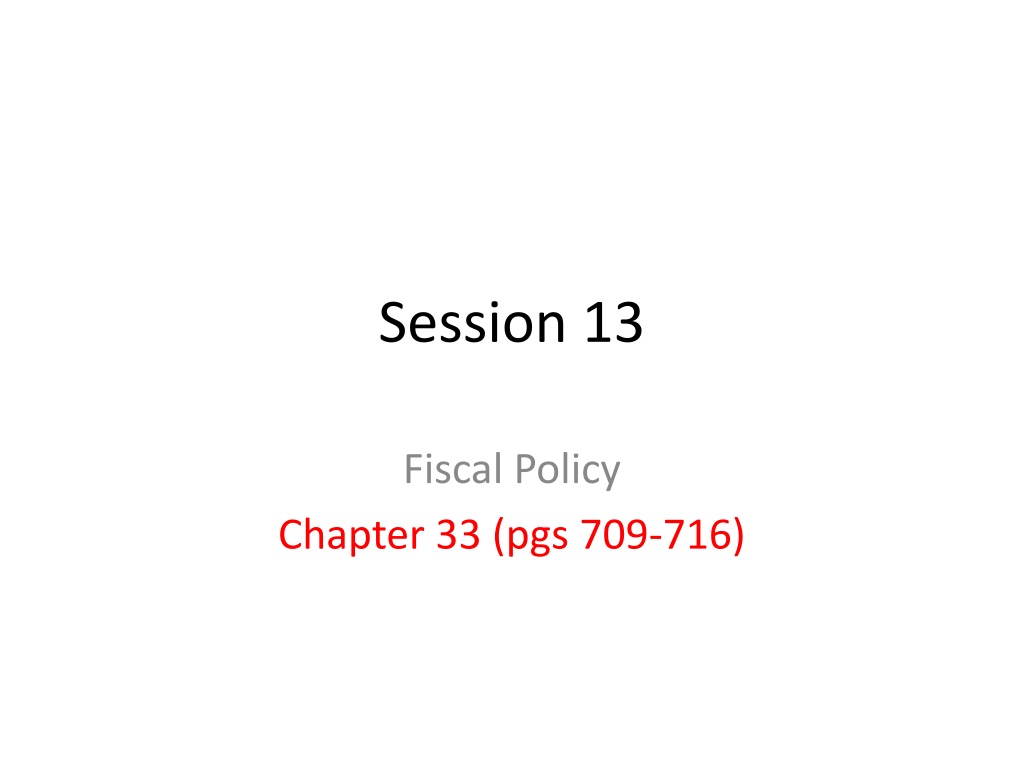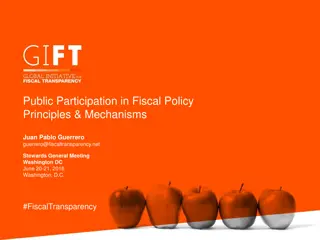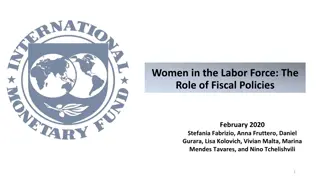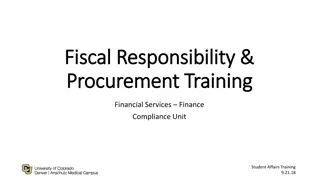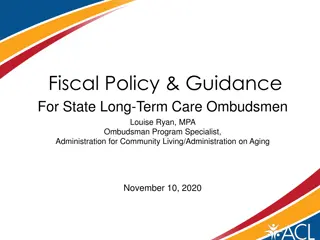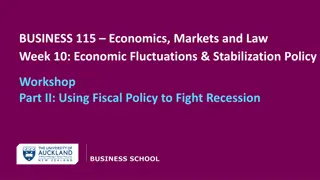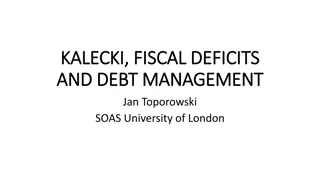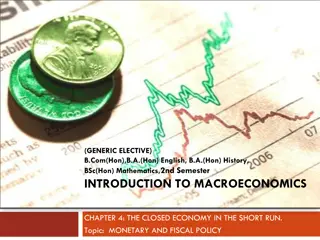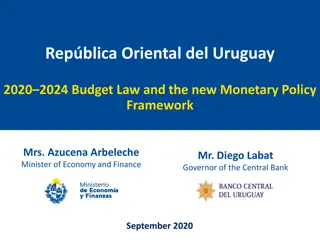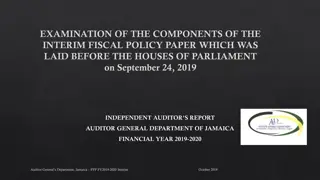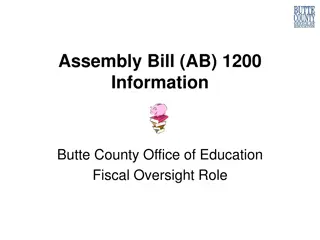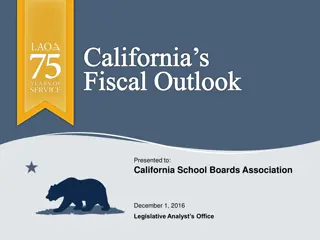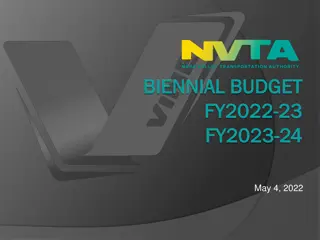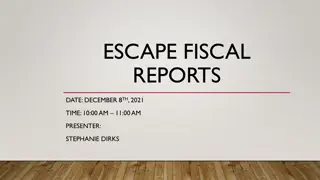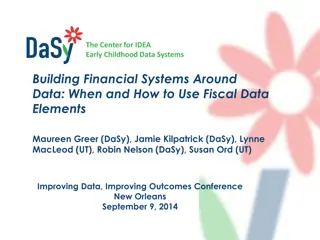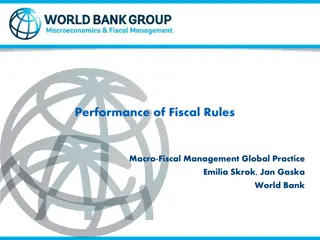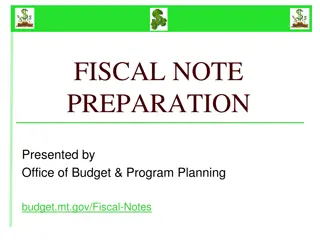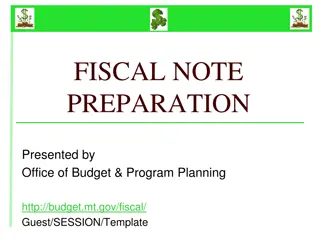Fiscal Policy: A Comprehensive Overview
Fiscal policy involves changes in government spending and taxes to influence macroeconomic objectives like employment, price stability, and economic growth. It includes expansionary and contractionary policies to manage aggregate demand and stabilize the economy. This overview covers types of fiscal policy, its effects on real GDP and the price level, cautionary notes on implementation lags, and the multiplier effect it has on the economy.
Download Presentation

Please find below an Image/Link to download the presentation.
The content on the website is provided AS IS for your information and personal use only. It may not be sold, licensed, or shared on other websites without obtaining consent from the author.If you encounter any issues during the download, it is possible that the publisher has removed the file from their server.
You are allowed to download the files provided on this website for personal or commercial use, subject to the condition that they are used lawfully. All files are the property of their respective owners.
The content on the website is provided AS IS for your information and personal use only. It may not be sold, licensed, or shared on other websites without obtaining consent from the author.
E N D
Presentation Transcript
Session 13 Fiscal Policy Chapter 33 (pgs 709-716)
Fiscal Policy What Fiscal Policy Is and What It Isn t Fiscal policy Changes in federal taxes and purchases that are intended to achieve macroeconomic policy objectives, such as high employment, price stability, and high rates of economic growth. Automatic Stabilizers versus Discretionary Fiscal Policy Automatic stabilizers Government spending and taxes that automatically increase or decrease along with the business cycle.
Recall that: Y=C+I+G+NX
Types of FP Expansionary Fiscal Policy: increasing gov t purchases or decreasing taxes to increase aggregate demand Contractionary Fiscal Policy: decreasing gov t purchases or increasing taxes to decrease aggregate demand
The Effects of Fiscal Policy on Real GDP and the Price Level A Summary of How Fiscal Policy Affects Aggregate Demand Table 15-1 Countercyclical Fiscal Policy ACTIONS BY CONGRESS AND THE PRESIDENT PROBLEM TYPE OF POLICY RESULT Recession Expansionary Increase government spending or cut taxes Real GDP and the price level rise. Rising Inflation Contractionary Decrease government spending or raise taxes Real GDP and the price level fall.
A Cautionary Note: Lags in Fiscal Policy In the case of fiscal policy, there is an important reason for caution: there are significant lagsin its use. Realize the recessionary/inflationary gap by collecting and analyzing economic data takes time Government develops a spending plan takes time Implementation of the action plan (spending the money takes time
Fiscal Policy and the Multiplier Fiscal policy has a multiplier effect on the economy. Expansionary fiscal policy leads to an increase in real GDP larger than the initial rise in aggregate spending caused by the policy. Conversely, contractionary fiscal policy leads to a fall in real GDP larger than the initial reduction in aggregate spending caused by the policy.
Fiscal Policy and the Multiplier The multiplier on changes in government purchases, 1/(1 MPC), is larger than the multiplier on changes in taxes or transfers, MPC/(1 MPC), because part of any change in taxes or transfers is absorbed by savings. Changes in government purchases have a more powerful effect on the economy than equal-sized changes in taxes or transfers.
Multiplier Effects of Changes in Taxes and Government Transfers Hypothetical Effects of a Fiscal Policy with Multiplier of 2
Deficits Versus Debt Deficit: the difference between the amt of money a gov t spends & the amt it receives in taxes over a given period. Debt: the sum of money a gov t owes at a particular point in time. Deficits and debt are linked, because government debt grows when governments run deficits. But they aren t the same thing, and they can even tell different stories.
The Budget Balance That is, expansionary fiscal policies make a budget surplus smaller or a budget deficit bigger. Conversely, contractionary fiscalpolicies make a budget surplus bigger or a budget deficit smaller.
Should the Budget Be Balanced? Most economists don t believe the government should be forced to run a balanced budget every year Yet policy makers concerned about excessive deficits sometimes feel that rigid rules prohibiting or at least setting an upper limit on deficits are necessary.
Deficits and Debt in Practice A widely used measure of fiscal health is the debt GDP ratio. This number can remain stable or fall even in the face of moderate budget deficits if GDP rises over time.
Stability Pactor Stupidity Pact? In 1999 a group of European nations adopted a common currency, the euro, to replace their national currencies. Members signed stability pact Keep deficit < 3% Limited the use of fiscal policy
Argentinas Creditors Take a Haircut During much of the 1990s, Argentina was experiencing an economic boom and the government was easily able to borrow money from abroad. However, the country slid into an economic slump. By 2001, the country was caught in a vicious circle: to cover its deficits and pay off old loans as they came due, it was forced to borrow at much higher interest rates. It took three years for Argentina to reach an agreement with its creditors. Argentina forced its creditors to trade their sovereign bonds debts of a sovereign nation for new bonds worth only 32% as much. Such a reduction in the value of debt is known as a haircut.
The Budget Balance The budget deficit as a percentage of GDP tends to rise during recessions (indicated by shaded areas) and fall during expansions.
The Budget Balance The budget deficit as a percentage of GDP moves closely in tandem with the unemployment rate.
Long-Run Implications of Fiscal Policy Persistent budget deficits have long-run consequences because they lead to an increase in public debt.
Problems Posed by Rising Government Debt Public debt may crowd out investment spending, which reduces long-run economic growth. And in extreme cases, rising debt may lead to government default, resulting in economic and financial turmoil. Can t a government that has trouble borrowing just print money to pay its bills? Yes, it can, but this leads to another problem: inflation.
Implicit Liabilities Implicit liabilities are spending promises made by governments that are effectively a debt despite the fact that they are not included in the usual debt statistics.
Practice Questions If the government wanted to close a recessionary gap of $100 with increased spending, would it want to increase spending by $100, more than $100, or less than $100? If the gov t increased spending by $50 million, what would be the specific effect on GDP? Assume MPC=0.2 Explain why a $1 increase in spending will likely have a larger impact on the economy than a $1 tax cut.
Answers 1) Less than $100 2) Multiplier = 1/(1-MPC)=1/.8=1.25 Effect: $50mil * 1.25 = $62.5 3) Has to do with the first round effect
